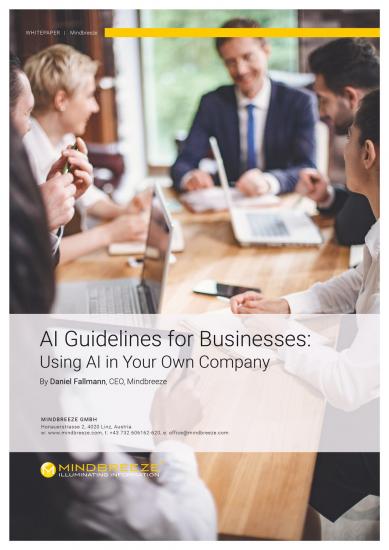The alliance of man and machine
Artificial intelligence, in the form of computer systems and robots, is gaining ground in our lives at an ever increasing pace. And not just for performing simple tasks. Quite the contrary, in the future these new technologies will be able to handle tasks that are far more creative and innovative.
While that might sound like a utopia, it has long since moved from fiction to reality.
Scientists in Saudi Arabia are already conducting research that goes far beyond drone taxis and cleaning robots, as evidenced by forward-looking projects like Neom.
Emerging trends and up-and-coming technologies are presenting opportunities that are virtually limitless. Companies need to use existing technologies to their business advantage now in order to capitalize on these opportunities, mitigate risks, and prepare for the challenges ahead.
NLP and AI support text comprehension
The age of digitalization brings with it an increasing variety of available data. As the number and distribution of data sources grows, so does the number of stakeholders involved in the production, distribution, and use of data. However, an organization’s data is of limited use unless it is able to understand the relationships and the different meanings of the various data sets.
The ability to process unstructured information presupposes the ability to understand the content – or at least the most important terms, their synonyms, and their correlations. Even if we haven’t yet managed to get technologies to think in context and, above all, in abstract terms, the systems and applications available today can make it a whole lot easier to cope with the colossal amounts of data.
Automatic speech recognition based on natural language processing (NLP)
This is a method for computer-based processing of natural language using rules and algorithms. This technology helps machines understand content and convert it into meaningful information. To do this, the machine not only needs to understand individual words and sentences, it also has to be able to grasp the total textual context, correlations, and supporting facts.
In contrast to machine language, however, natural language is unstructured, ambiguous, and subject to a variety of other parameters (such as dialect, slang, and irony). For many texts, an understanding that is strictly rule-based reaches its limitations fairly quickly.
This is where artificial intelligence (AI) comes in. In machine learning (ML), algorithms create their own rules based on statistical probabilities and as a function of the context. While ML depends on human guidance, deep learning involves artificial neuronal networks that are able to independently recognize and “understand” complex linguistic relationships.
AI is constantly learning and optimizing its performance
Training data – in this case, text documents – is needed to train the relevant algorithms. Initially, this might involve data that has already been classified and for which the type of information it contains or what information needs to be extracted from the text has been entered manually. The more clues the AI receives, the better it can derive correlations and apply its experience to new, completely unfamiliar texts.
Use cases throughout the company
There are application possibilities in every company. For instance, automatic text recognition can be used in the incoming mail department, in customer service, in support, and even in production. From reading e-mails and messages to understanding and linking complex maintenance protocols and documentation, NLP, ML, and DL slash personnel costs and create greater process efficiency.
Fostering interaction and progress
Siri or Alexa, drones, autonomous vehicles, assembly line and storage robots, operation robots, auxiliary robots, and others will serve as our assistants today, and probably for several years to come. But the interaction between man and machine continues to intensify. Although this is only the beginning, what today seems like utopia could indeed become reality in the future.
Have you ever considered where AI could be implemented in your business? Our AI Guide for Business offers some valuable ideas and input.
 Have you ever considered where AI could be implemented in your business? Our AI Guide for Business offers some valuable ideas and input:
Have you ever considered where AI could be implemented in your business? Our AI Guide for Business offers some valuable ideas and input:
Download White Paper
Latest Blogs
The New Collaborative Era: Humans + AI in 2026
Moving Beyond the Automation Fear NarrativeFor years, public debate around AI focused on a single question: Will machines replace human workers?But in 2026, that narrative is no longer relevant.
Why AI Trust Will Define Enterprise Leadership in 2026
AI Without Trust Is AI Without ImpactAs AI becomes deeply embedded in enterprise decision-making, scrutiny is rising. Organizations no longer ask, “Can AI generate insights?” The real question is: “Can we trust those insights enough to act on them?”


